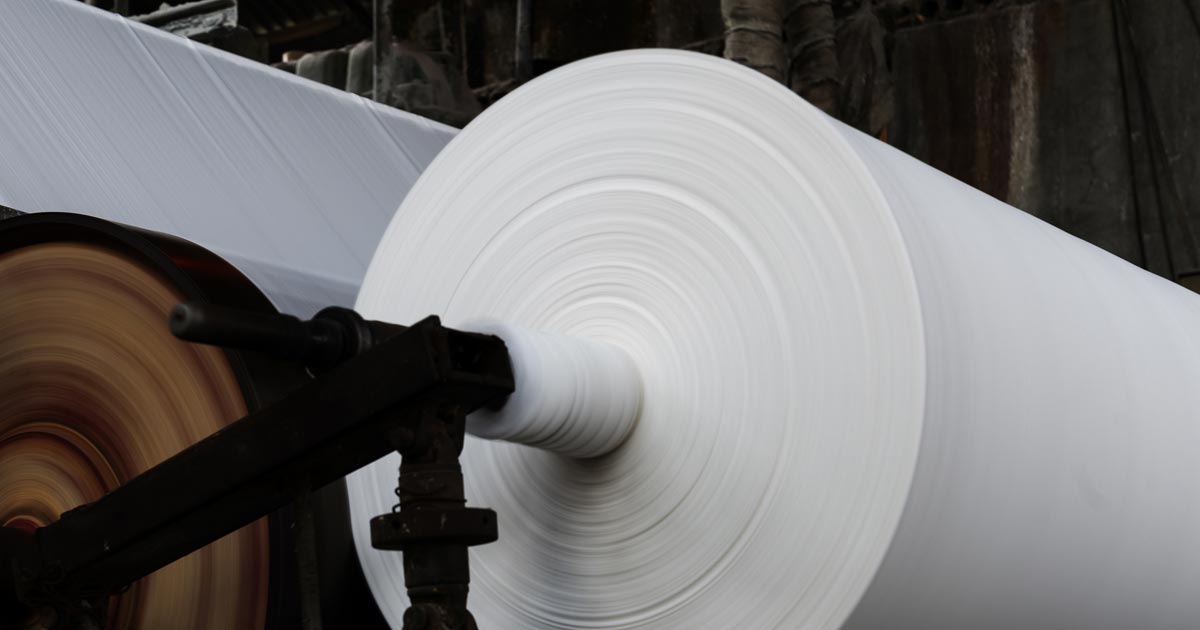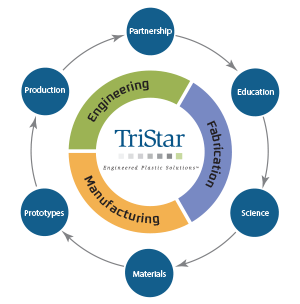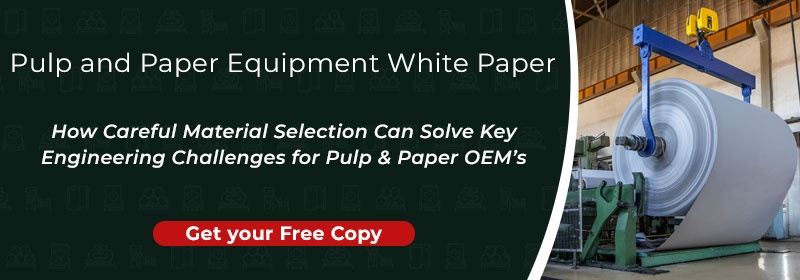
Intensive processing is required to turn wood fibers into graphic paper, cardboard, packaging, and a variety of other paper-based products.
This blog examines the basics of the process and equipment required to get the job done.
The article below is part of our series examining some of the biggest challenges for pulp and paper equipment manufacturers (and how the right materials can help). For a deep dive on this topic, please see our guide here.
A Complex Industry Process Full of Challenges for Pulp and Paper Equipment Manufacturers
Pulp and paper processing is one of the most varied industries around, so the process below is necessarily generalized. It represents a prototypical modern paper-making process (we provide a look at the history of the industry in our blog here).
Paper products can be made from a variety of different wood pulps, fibrous plants, recycled materials, and more. Wood chips, the most common source today, can be made from logs but are also commonly sourced as a residual product of sawmills, furniture factories, and other timber-related industries. Any object that becomes embedded in a tree can ultimately become a contaminant within woods chips. Old fence posts, metal bolts, and even bullets have been known to emerge in pulp and paper processing facilities.
Industry equipment must be ready to process any of these inputs into quality pulp. To accommodate all this variation, the industry uses a variety of intensive processing techniques. All of them share the same goal: separating the cellulose fibers used to make paper. This processing can be accomplished using chemical pulping, mechanical pulping, or some mixture of both. Within these two broad categories, operating parameters can vary substantial from mill to mill—pulp and paper companies are always looking for opportunities to employ more aggressive processing techniques that enhance yield. More aggressive downstream processing can also drive savings by limiting the amount of filtering and cleaning required for raw inputs.
- Mechanical Pulping: rather than using chemicals, a grinder is used to press against woodchips and physically separate cellulose fibers. This process tends to result in shorter fibers which exhibit less strength, a typical base for newsprint paper. After being finely ground, techniques like steaming can be used to further process the wood material.
- Chemical Pulping: the most common process in the United States, wood chips are cooked in a “digestor” machine (see below) at an elevated temperature and pressure. This digestor also includes a special chemical mix designed to dissolve lignin, a substance which binds wood fibers to one another. This process preserves longer wood fibers, enabling stronger paper products ideal for applications like photo-paper and paperboard.
By the time wood fibers are separated, they have become a mix of fibers and water called pulp. Pulp forms the base ingredient for almost any paper product. Pulp is then thoroughly washed and decontaminated to ensure no processing chemicals remain in the paper. For white paper, the pulp is bleached to remove any color.
Finally, the wet pulp must be drained. This is typically accomplished by pumping the pulp onto rolling, wire-screen mats that allow water to drain as the fibers press down and become interwoven into sheets. Altering the thickness of the pulp, the length of the drying process, and other key parameters results in paper with different final qualities.
The final step is passing through a long series of rollers and heated drums which remove any remaining moisture. Dried paper can then be polished, smoothed, and wound onto rolls or cut into individual sheets.
Examples of Pulp and Paper Equipment
These are just a few examples of the solutions offered by pulp and paper equipment manufacturers.
- Chippers: woodchippers are used to turn pulpwood into evenly sized chips, which will allow for cooking or grinding processes to work effectively and uniformly. Stationary chippers are employed at paper mill facilities, and mobile units are also used directly at timber yards.
- Pulpers: “pulper” also describes a different type of equipment used for food products, but a paper pulping machine is very different. Mechanical pulping machines are essentially large (usually cylindrical) grinders where wood chips can be ground into pulp.
- Digesters: Digesters are the key piece of chemical pulping equipment. They essentially look like large tanks—inside, chips are processed using caustic chemicals, rapid pressure changes, and heat.
- Refiners: refining processes paper fibers through brushing, cutting, and hydrating, all of which can help determine different final paper qualities. This is accomplished using hydraulic refining machines that utilize high-speed rotating discs to treat pumped-in paper slurry.
- Fourdrinier Machines: originally developed in England by the French Fourdrinier brothers, this basic design has become so commonplace (with some evolution) that these machines are now often simply called “paper machines.” They use a conveyor belt, traditionally made of wire mesh, to continuously drain water from paper as it moves down the line.
Learn About Key Challenges for Pulp and Paper Equipment Manufacturers
The process described above is full of challenges for pulp and paper industry OEM’s. Caustic chemicals are used to break down pulp, wood chips and paper dust can be highly abrasive to the wrong materials, and intensive water use drives a need for non-absorbent materials. Relatively high heats are commonplace. Any of these issues demands careful component engineering. When all of these challenges are present in the same paper mill, selecting the right materials can be like threading a needle.
That’s why, in our experience, pulp and paper industry applications are typically best served by carefully engineering materials and components to reflect specific operating challenges.
We take a deeper look at some of these challenges in our free downloadable in-depth guide:









